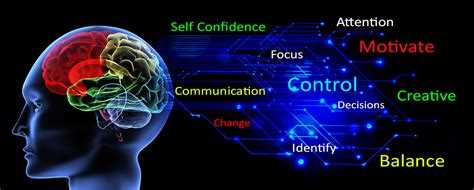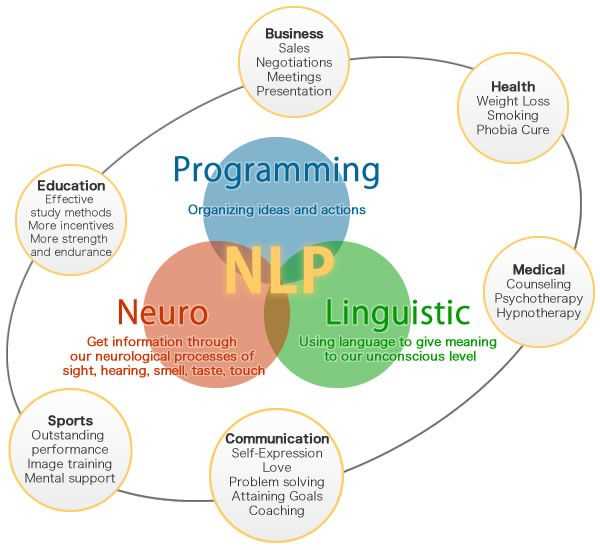Neuro Linguistic Programming (NLP) is a psychological approach that focuses on the connection and interactions between the mind, language, and behavior. It was developed in the 1970s by Richard Bandler and John Grinder as a way to study and model the strategies and techniques of successful individuals in various fields.
NLP is based on the idea that our thoughts, language, and behaviors are all interconnected and influence each other. By understanding and changing the patterns of our thinking and communication, we can improve our behavior and achieve more positive outcomes in our personal and professional lives.
NLP works by using a variety of techniques and tools to explore the subconscious mind, reframe negative beliefs and thought patterns, and enable individuals to create new, more empowering behaviors and attitudes. It draws on a range of psychological theories and practices, including cognitive psychology, hypnosis, and semantics.
In NLP, practitioners often use visualization, guided imagery, and hypnosis to help individuals access their subconscious mind and make positive changes at a deep level. By understanding the language patterns and nonverbal communication cues of others, individuals can also improve their interpersonal skills and become more effective communicators.
NLP has been applied in various fields, including therapy, coaching, education, sales, and leadership development. It is often used to help individuals overcome fears, phobias, and limiting beliefs, and to increase self-confidence and motivation. Many individuals also use NLP techniques for personal growth and self-improvement.
What is NLP and its History?
Neuro Linguistic Programming (NLP) is a psychological approach that explores how our thoughts, language, and behaviors are interlinked and how they can be modified to achieve specific goals and outcomes. It is based on the belief that by understanding and modeling the patterns of successful behaviors and thought processes, we can replicate those patterns to achieve similar success in our own lives.
NLP was developed in the 1970s by Richard Bandler, a student of mathematics and psychology, and John Grinder, a linguist and psychologist. They studied and modeled the work of successful therapists and communicators such as Virginia Satir, Fritz Perls, and Milton Erickson. By analyzing and replicating their techniques, Bandler and Grinder sought to create a system that could be used to improve communication, personal development, and therapy.
The name “Neuro Linguistic Programming” reflects the three main components of the approach:
- Neuro: Refers to the neurological processes that occur within our mind and body.
- Linguistic: Refers to the language and non-verbal communication systems that we use to represent our experiences and thoughts.
- Programming: Refers to the patterns of behaviors and thought processes that we have developed over time.
Since its inception, NLP has been applied to various fields, including business, education, therapy, and personal development. It has been praised for its ability to facilitate rapid and lasting change by identifying and modifying underlying patterns of thought and behavior.
However, it is important to note that NLP has also faced criticism and controversy. Some skeptics argue that the scientific basis of NLP is lacking and that its effectiveness may be overstated. Despite the debates, NLP continues to be widely studied and practiced by many professionals and individuals seeking personal growth and improvement.
The Core Principles of NLP
- Subjective Experience: NLP recognizes that each individual experiences the world subjectively, and that their beliefs, thoughts, and perceptions shape their reality. NLP seeks to understand and work with these subjective experiences.
- Rapport: Rapport is the establishment of a harmonious and trusting relationship between two or more individuals. NLP emphasizes the importance of building rapport to effectively communicate and influence others.
- Outcome-Oriented: NLP focuses on setting clear and well-defined outcomes. By identifying desired outcomes, individuals can then work towards achieving them using specific strategies and techniques.
- Modeling: NLP is based on the idea that excellence can be learned and replicated. By observing and studying successful individuals and their strategies, NLP aims to model and transfer their behaviors and beliefs to achieve similar results.
- Flexibility: NLP encourages individuals to be flexible in their thinking and behavior. By adopting different strategies and perspectives, individuals can effectively adapt to various situations and overcome challenges.
- Language and Communication: NLP places great importance on the language and communication styles used by individuals. By using precise and influential language patterns, one can effectively convey their ideas and beliefs to influence and persuade others.
- Feedback: NLP emphasizes the importance of receiving and utilizing feedback to enhance personal growth and development. By actively seeking feedback and making adjustments based on it, individuals can continuously improve their communication and behavior.
These core principles form the foundation of NLP and guide its techniques and strategies. By understanding and applying these principles, individuals can enhance their communication, influence, and personal growth.
The Benefits of NLP
NLP offers a range of benefits that can improve various aspects of a person’s life. These benefits include:
- Better communication skills: NLP techniques can enhance communication skills by teaching individuals to understand and interpret verbal and non-verbal cues, enabling them to more effectively express themselves and understand others.
- Improved relationships: By improving communication skills and understanding others’ perspectives, NLP can help in building and maintaining healthier and more fulfilling relationships.
- Personal development: NLP techniques can assist in self-discovery and personal growth, enabling individuals to set and achieve their goals, overcome challenges, and unlock their full potential.
- Increased confidence: NLP can help individuals overcome limiting beliefs and develop a more positive mindset, resulting in increased self-confidence and self-esteem.
- Effective leadership: NLP can enhance leadership skills by teaching individuals how to inspire and motivate others, build strong teams, and effectively manage conflicts.
- Reduced anxiety and stress: NLP techniques such as anchoring and reframing can help individuals manage and reduce anxiety and stress, leading to improved emotional well-being and overall mental health.
- Enhanced problem-solving: NLP provides tools and strategies for problem-solving, helping individuals approach challenges with a more resourceful and creative mindset.
- Improved learning and memory: NLP techniques can aid in effective learning and memory retention, allowing individuals to acquire new knowledge and skills more efficiently.
- Healthier habits: NLP can assist in breaking unwanted habits and developing healthier ones, such as quitting smoking, managing weight, or improving sleep patterns.
Overall, NLP offers a wide range of benefits that can positively impact various areas of life, enabling individuals to achieve personal and professional success, improve relationships, and enhance overall well-being.
How NLP Works: The Communication Model
The field of Neuro Linguistic Programming (NLP) operates on the belief that successful communication and personal development are achieved through understanding how people perceive and process information. The NLP communication model provides a framework for analyzing and improving the effectiveness of communication.
The NLP communication model consists of several key components:
- Sensory Input: The first step in communication is the sensory input, where individuals observe and absorb information from their environment through their five senses: sight, hearing, touch, taste, and smell.
- Processing: Once the sensory input is received, it is then processed by the mind. This includes filtering the information, making meaning out of it, and constructing internal representations.
- Internal Representations: Internal representations refer to the mental images, thoughts, feelings, and sounds that individuals create to represent their experiences and perceptions.
- State and Physiology: State and physiology describe the internal and external states of an individual, including their mood, emotions, physical sensations, and body language. These factors play a significant role in how information is communicated and received.
- Communication: The communication stage involves encoding the internal representations into language and non-verbal cues to express thoughts, emotions, and intentions to another person.
- External Representations: External representations are the sensory input received by the other person, including what they see, hear, and perceive from the communication.
- Processing: Similar to the processing stage of the sender, the receiver’s mind filters, interprets, and creates internal representations based on the external representations received.
- Response: Finally, based on their internal representations and the interpretation of the external representations, the receiver formulates a response and communicates it back to the sender.
The NLP communication model emphasizes that effective communication involves understanding and aligning the different components of the model. By being aware of one’s own and others’ sensory input, processing styles, internal representations, states and physiology, and communication techniques, individuals can enhance their ability to connect, understand, and influence others.
NLP techniques are designed to improve communication by helping individuals recognize and adjust these components to achieve desired outcomes. By understanding how people perceive and process information, NLP provides tools and strategies to enhance communication skills, build rapport, and influence others in a positive way.
Overall, the NLP communication model provides a comprehensive framework for understanding the intricacies of human communication and offers practical techniques for enhancing interpersonal effectiveness.
Common Techniques Used in NLP
Neuro Linguistic Programming (NLP) employs a variety of techniques to help individuals improve their communication skills, change their thought patterns, and achieve personal and professional goals. Some of the most common techniques used in NLP include:
- Rapport Building: Building rapport is a technique used to establish a strong connection with others. It involves matching and mirroring the other person’s body language, tonality, and speech patterns to create a sense of similarity and trust. This technique can enhance communication and build positive relationships.
- Anchoring: Anchoring is a technique that associates an emotional or mental state with a specific trigger, such as a gesture, word, or image. By repeatedly pairing the trigger with the desired state, individuals can access that state whenever they encounter the trigger. This technique can be used to manage emotions, overcome fears, and enhance motivation.
- Reframing: Reframing involves changing the way an individual views a situation by providing an alternative perspective. This technique can help individuals shift their mindset and find new solutions to problems. By reframing negative thoughts or limiting beliefs, individuals can cultivate a more positive and empowering mindset.
- Swish Pattern: The swish pattern is a technique used to replace an unwanted behavior or thought with a desired one. By visualizing the unwanted behavior becoming small and distant while simultaneously bringing up a vivid image of the desired behavior, individuals can create a new neural pathway in their brain. This technique can be effective for breaking habits and creating positive change.
- Meta-Model: The meta-model is a set of language patterns used to uncover and challenge limiting beliefs, assumptions, and generalizations. By asking specific questions, individuals can gain clarity and challenge their own thought patterns. This technique can help overcome negative self-talk and improve communication.
- Milton Model: The Milton model is a set of language patterns used to induce trance-like states and promote change through storytelling, vague language, and embedded suggestions. This technique can be used to communicate more effectively, inspire change, and enhance persuasion skills.
- Outcome Setting: Outcome setting involves clearly defining and articulating personal or professional goals. By setting specific, measurable, achievable, relevant, and time-bound (SMART) goals, individuals can increase their motivation and focus. This technique can facilitate goal achievement and personal growth.
These are just a few of the many techniques used in NLP. By utilizing these techniques, individuals can improve their communication abilities, develop new ways of thinking, and achieve greater success in various areas of life.
Applications of NLP in Everyday Life
Neuro Linguistic Programming (NLP) has proven to be a valuable tool in a wide range of applications, enhancing personal and professional development. Here are some of the ways NLP can be applied in everyday life:
- Communication: NLP techniques can improve communication skills, allowing individuals to effectively express themselves and understand others better. By analyzing the language patterns and non-verbal cues, NLP helps in building rapport, resolving conflicts, and fostering cooperation.
- Goals and Motivation: NLP provides a framework for setting and achieving goals. Through visualization techniques and anchoring, individuals can enhance their motivation, overcome obstacles, and maintain focus towards their desired outcomes.
- Self-Confidence: NLP helps in developing self-confidence by addressing limiting beliefs and changing negative thought patterns. Techniques like reframing and modeling can empower individuals to overcome fears, build resilience, and adopt a positive mindset.
- Emotional Management: NLP offers strategies for managing emotions effectively. By understanding the structure and processes of emotions, individuals can gain control over their emotional states and respond more resourcefully in challenging situations.
- Behavioral Changes: NLP techniques can assist in modifying unwanted behaviors and creating new empowering habits. By exploring and altering internal representations, individuals can reshape their perceptions, beliefs, and motivations, leading to positive changes in behavior.
- Learning and Study Skills: NLP provides techniques to enhance learning and memory. By utilizing strategies such as chunking, anchoring, and visualization, individuals can improve their ability to absorb, retain, and recall information more effectively.
- Leadership and Influence: NLP skills can be applied in leadership roles to inspire and influence others. Techniques like rapport building, calibration, and persuasive language patterns help leaders establish trust, motivate their teams, and effectively communicate their vision.
These are just a few examples of how NLP can be applied in everyday life. Whether it is in personal relationships, professional settings, or self-improvement journeys, NLP offers practical tools and strategies for personal growth and success.
Scientific Research and Evidence for NLP
Neuro Linguistic Programming (NLP) has been the subject of scientific research and studies to evaluate its effectiveness and validity. While there is ongoing research in the field, here are some key findings and evidence for NLP:
- Improved Communication: Several studies have shown that NLP techniques can enhance communication skills, including fostering rapport, active listening, and effective questioning techniques.
- Anchoring Techniques: Research indicates that NLP anchoring techniques, where a specific sensory stimulus is associated with a desired emotional state or behavior, can be effective in facilitating positive changes in an individual’s emotional state.
- Goal Achievement: NLP techniques such as setting well-formed outcomes and visualization have been found to be helpful in goal setting and achievement, improving performance in various areas of life.
- Managing Phobias: Studies have shown that NLP techniques, such as the Fast Phobia Cure, can be effective in reducing and alleviating phobias and anxiety disorders.
- Behavioral Change: Research suggests that NLP interventions can facilitate positive behavioral change, including smoking cessation, weight loss, and improving self-esteem and motivation.
It is important to note that while there is scientific evidence supporting the effectiveness of NLP in certain areas, more research is needed to validate its claims across a wider range of applications.
Overall, scientific research on NLP provides encouraging evidence of its potential effectiveness in various domains of personal development, communication, and behavior change. However, it is also important to critically evaluate the quality and methodology of the studies conducted, as with any scientific research.
Questions and answers
What is Neuro Linguistic Programming (NLP) and how does it work?
Neuro Linguistic Programming (NLP) is a psychological approach that focuses on the connection between neurological processes (neuro-), language (linguistic), and patterns of behavior and thought (programming). It is based on the belief that our thoughts, language, and behaviors are interconnected, and by changing one element, we can influence the others. NLP works by identifying and modeling patterns of excellence in thinking, communication, and behavior to achieve specific outcomes.
Is NLP a form of therapy?
Yes, NLP is often used as a form of therapy. It can be used to address a wide range of issues such as phobias, anxiety, limiting beliefs, and emotional traumas. NLP techniques are applied to help individuals reprogram their thoughts, beliefs, and behaviors, allowing them to overcome challenges and achieve personal growth.
How is NLP different from other forms of therapy?
NLP differs from other forms of therapy in its focus on the relationship between language, thought processes, and behavior. While traditional therapy may focus on exploring past experiences and emotions, NLP emphasizes the power of language and patterns of thought in shaping our behavior. NLP techniques are often more goal-oriented and can achieve rapid results compared to other therapeutic approaches.
Can anyone learn NLP?
Yes, anyone can learn NLP. NLP techniques and principles can be taught and applied by individuals from all backgrounds and professions. There are numerous NLP training programs and courses available, ranging from introductory workshops to more advanced certifications.
Is NLP evidence-based?
The evidence supporting NLP is mixed. While there are numerous anecdotal success stories, scientific studies on NLP have produced varying results. Some studies suggest positive outcomes, while others question the validity and effectiveness of NLP techniques. It is important to approach NLP with an open mind and consider individual experiences and research when evaluating its efficacy.


